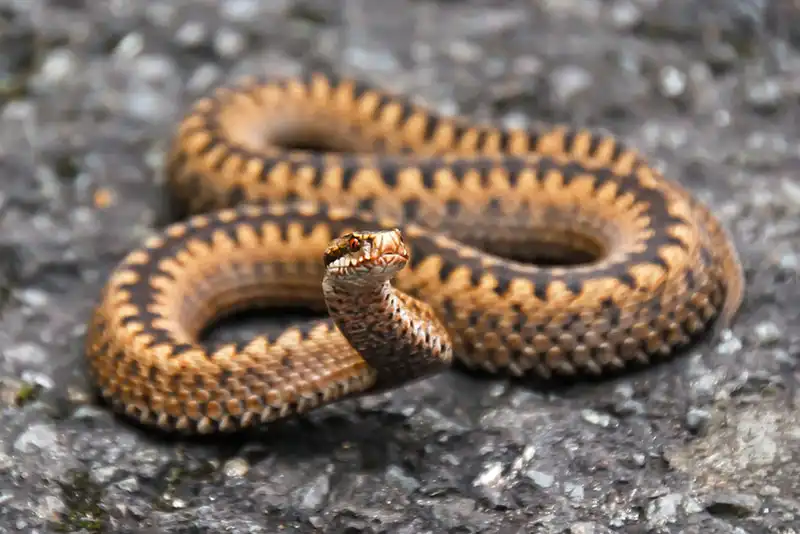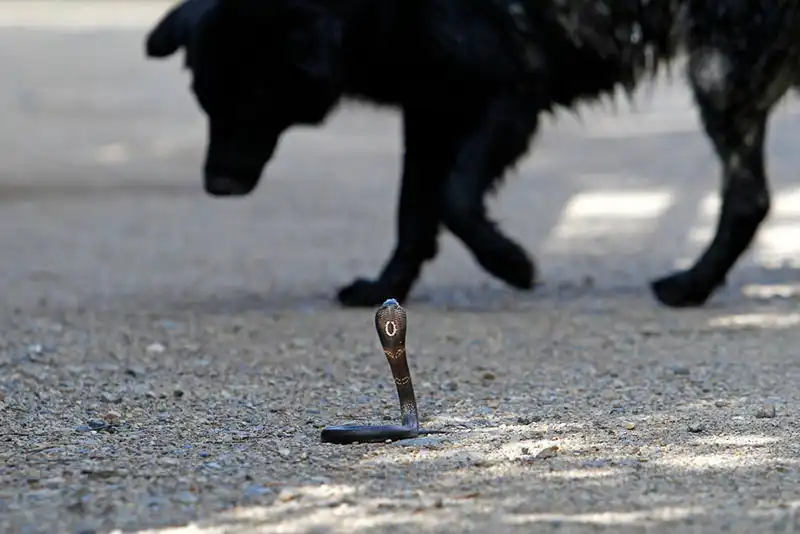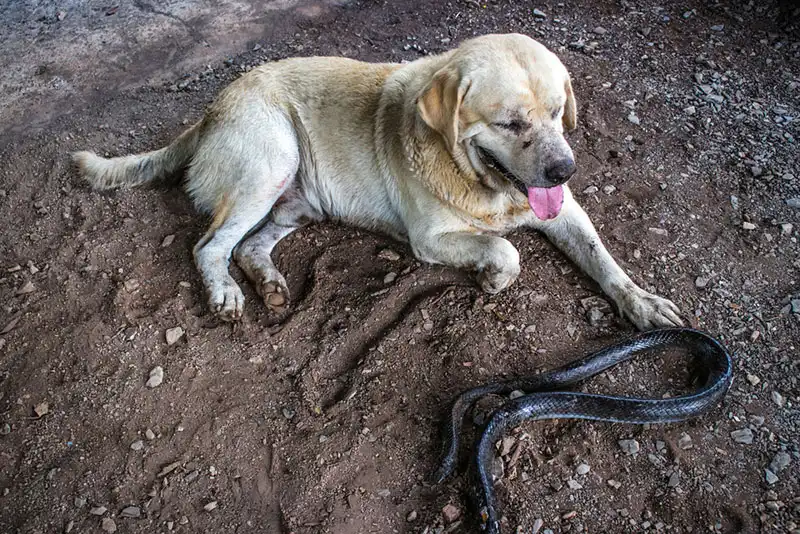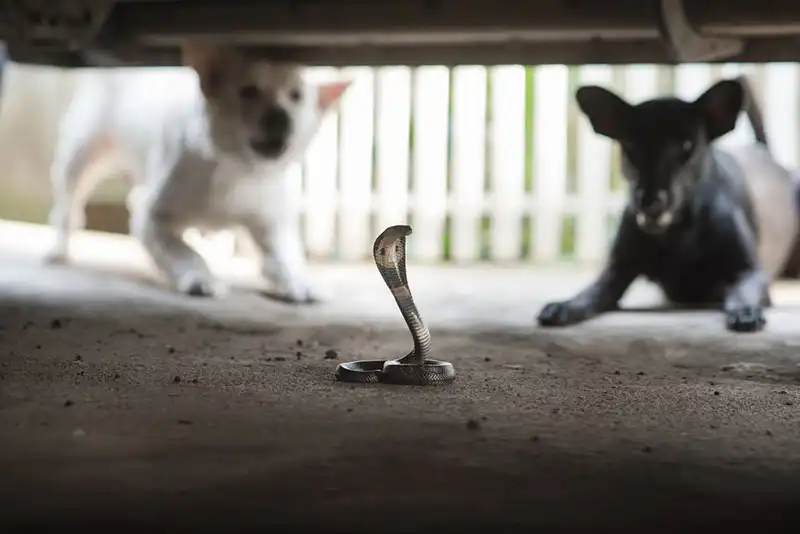Symptoms of a Dog Snake Bite
Common Venomous Snakes
- Common viper . The viper is the most common poisonous snake in Russia. Its average length is about 70-85 cm, but in northern latitudes there are specimens up to 1 meter. The color is gray and dark gray, and may have a zigzag pattern on the back. The shape of the head is triangular and wide, reminiscent of a spear.
If a viper bites a dog, the probability of a fatal outcome is small if timely assistance is provided.

- Steppe viper . This is a grey-brown snake with a dark stripe on the spine. It is found in the European part of the country, in the North Caucasus, and in Crimea. A bite can lead to the death of the animal in 2-5% of cases.

- Caucasian viper and Dinnik’s viper . The habitat of these poisonous snake species is the forests of the Western Caucasus and the alpine belt. Representatives of both species are listed in the Red Book, as they are rare. They have a bright color – red-brick or orange-yellow. The bite is quite painful. Like other species of vipers, the Caucasian does not attack first. Its bite can be fatal for 2-5% of animals.
- The copperhead snake is a subspecies of viper. It lives from the Salsk steppe in the lower reaches of the Don and Volga rivers in the west to Primorsky Krai in the east. Due to its brown and gray-brown color, it is difficult to notice in the bushes. It is active in the spring, when it is time to mate. Aggressive individuals have strong poison, which can lead to death in the bitten animal.
- Gyurza . The largest and most poisonous snake of the viper family. It lives in the North Caucasus and Dagestan. The appearance of the Gyurza is quite impressive: from 1.5 to 2 meters in length and up to 3 kg in weight. Unlike other species of vipers, the Gyurza can attack a potential enemy first without warning and does so with lightning speed. It is especially dangerous in the spring, during the mating season. It is listed in the Red Book.
Is a viper or other snake bite dangerous for a dog?
The severity of a snake bite depends on the amount of venom injected. Bites in the spring and from young snakes are more toxic, as more venom is injected. A bite from a very large snake is considered more dangerous, especially in small dogs. Bites to the tongue or neck are more life-threatening due to progressive swelling. Bites to the torso are often more serious than bites to the muzzle or limbs. Bites from a dying snake are dangerous.snakes.
About 20% of snake and viper bites are “dry” because they contain little or no venom.

How does poison work?
Snake venom is called ophidiotoxin. The composition of the venom is complex, it is a mixture of albumins, globulins, albumoses, calcium salts, magnesium, phosphates, chlorides and enzymes.
A common clinical effect of the venom is an immediate decrease in systemic blood pressure due to vasodilation.arteries. The venom of many snakes can cause aggregationplatelets and a decrease in their number in the blood, muscle necrosis. Serious complications from the ingestion of large amounts of venom from snake bites include ventricular arrhythmias and heart failure, acute renal failure, DIC syndrome and airway obstruction.

Symptoms of a Dog Snake Bite
Clinical signs of a snake bite in dogs include: acute pain and extensive local swelling, enlargement of regional lymph nodes.
Over the next 24 hours, diffuse hemorrhages may appear, and necrosis of the tissues surrounding the bite site is possible.
Systemic reactions can occur within five minutes or up to 48 hours of the bite. This may include anaphylaxis.and its manifestations: weakness, nausea, vomiting , disorientation, acute hypotension, abdominalpain, urinary and fecal incontinence, fever, tachycardia, arrhythmia, erythema, respiratory failure.
There may also be disturbances in the blood coagulation system, including DIC syndrome, bleeding, damage to the heart muscle and kidneys.
Bites to the face or neck lead to more dangerous symptoms, because rapidly increasing swelling of tissues in the nose or tongue area can cause suffocation with irreversible sad consequences. It is much worse if the poison gets into the general bloodstream – this will lead to sudden and severe poisoning of the body with a high risk of death.

What to do if a dog is bitten by a viper – first aid
It will be better when the owner sees that the dog has been bitten by a snake, notices the moment of the fight with the reptile. The pet can attract attention by barking or excited behavior when meeting a snake. But, unfortunately, the owner does not always immediately notice that very moment of the bite, but only later understands what happened when clinical symptoms appear in the bitten dog. Most often, the viper bites the dog in the head, neck and limbs.
The rate of increase in intoxication is rapid, and the dog requires immediate assistance!
So, what should you do if your dog is bitten by a snake:
Restrict movement.The injured dog must be immobilized because increased muscle activity accelerates blood circulation and leads to faster movement of the poison through the lymphatic pathways. And the outflow of lymphfrom a motionless limb will be less significant. When transporting the dog, it is better to hold it in a lying lateral position.
Apply a cold or ice compress.To prevent swelling and provide a local anesthetic effect, it is recommended to apply ice to the bite site.
Give an antihistamine.To reduce the likelihood of an anaphylactic reaction, the bitten animal can be given an antihistamine. This can be Suprastin at a dose of 0.5 mg/kg. Try to always keep an antihistamine in your travel and home medicine cabinet.
Provide the animal with plenty of water to drink.It is necessary to give a lot of water to a bitten dog, because a large volume of liquid helps to remove the poison from the body.
Deliver to a veterinary clinic.The results of subsequent treatment are influenced by the speed of first aid from the moment of the bite and the timely delivery of the animal to a veterinary institution.
Veterinary care
In a veterinary clinic, if a snake bite is suspected based on the patient’s medical history, the patient is admitted as an emergency case.
Initially, a venous catheter is inserted and blood samples are taken. The examination should include a complete blood count, biochemical blood tests , urine analysis, platelet count, and coagulation system testing (coagulogram).
The patient is treated urgently, as a critically ill person. It is aimed primarily at relieving acute pain, preventing systemic reactions such as anaphylactic shock, and lowering blood pressure. In the event of blood loss or the development of coagulopathyAn urgent transfusion of donor blood will be required.
In the absence of contraindications, corticosteroid administration will be required .for rapid relief of inflammation and pain relief. The recommended dose is 0.1 mg/kg Dexamethasone intravenously or 1 mg/kg Prednisolone orally every 12 hours until pain, inflammation and tissue swelling are reduced.
Systemic antibiotic therapy is also necessary to reduce the risk of secondary infection. A combination of drugs including first and third generation cephalosporins, penicillin and enrofloxacin is recommended. Due to the possible development of acute renal failure in patients bitten by snakes, nephrotoxic drugs are avoided.antibiotics.
Monitoring is the same as for all critically ill patients. Particular attention is paid to measuring blood pressure, ECG, urine output, the state of the blood coagulation system and swelling of the affected area. Swelling in the neck, head and muzzle may lead to airway obstruction and thus pose a threat to life.
Surgical treatment of the wound is performed if extensive tissue necrosis is detected. Often, the tissue in the bite area is rejected after a few days. Necrotic areas are removed and the wound is kept clean.
What should you not do if your dog is bitten by a snake?
Cut the skin at the site of the bite! Since the poison acts quite quickly, cuts do not help, but only cause additional trauma with the risk of developing a secondary infection.
Treat the wound with alcohol-containing products! This may accelerate the reaction of the poison.
Apply a tight bandage or tourniquet above the bite area! This may disrupt blood flow in the tissue and lead to necrosis.
Use folk remedies! There is no evidence of the effectiveness of such remedies for snake bites. This will only be regarded as a loss of precious time for providing assistance.
Consequences of snake bites
Snake bites are rarely fatal in large and medium-sized dogs. However, for dwarf breeds, older dogs, or dogs with a history of pathologies, the consequences of bites can be severe and even tragic.
Breeds that are more sensitive to snake venom include: St. Bernard , German Boxer , Rottweiler , English Bulldog , American Molosser.
The most poison-resistant dog breeds are considered to be: hounds, huskies , Caucasian and Central Asian shepherds, spaniels, wirehaired pointers, as well as large-sized crossbreeds. But this does not mean that they do not require veterinary care!
How to protect a dog from being bitten?
Unfortunately, there are no universal ways to prevent a dog from encountering snakes.
Preventing an emergency is the main way to prevent bites. Walking your dog on a leash will help reduce the risk. Try to avoid old snags and stumps, thick bushes. Do not let your pet near large rocks on the shady side, do not allow it to dig up mouse and rat holes. Since there may be snakes hunting rodents nearby. Remember that snakes are active and more aggressive from May to September.
Train your dog to follow commands without question. The dog does not understand the danger of a snake, but reacts to movements, sounds and smells. If you notice a snake, command: “Come to me” so that the pet comes to you and sits next to you. If you see that it is trying to sniff a snake, say the command “No” so that the dog runs away from it.






